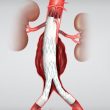This last year, new data in coronary disease gave way to changes in practices and new hypotheses, when not simply further justified the already existing evidence. In this new editorial section, we share the most relevant of last year’s works to keep you up to speed on the main topics in the field. The Most...
The Most Read Articles of 2021: Coronary Disease
A new year is coming to an end and at SOLACI we are going over the most read studies on our website, on a vital topic, peripheral vascular disease. Follow us to keep up to date. Most Read Articles on Coronary Disease 01- Post MI Betablockers for Good? Patients receiving optimal medical treatment after MI...
TCT 2021 | FAVOR III: Angiography-Derived FFR: An Event-Prevention Tool
Compared with visual estimation of lesions, using quantitative angiography-derived fractional flow reserve (quantitative flow ration, QFR) provides better clinical outcomes at one year for angioplasty. These results emerge from the Chinese FAVOR III study, presented at the 2021 TCT scientific sessions and simultaneously published in The Lancet. The simplicity and safety offered by QRF—since there is...
TCT 2021 | FAME 3: Surprises in a Long-Awaited Study
Angioplasty could not reach non-inferiority to surgery to treat patients with three-vessel lesions. In this head-to-head study of both revascularization strategies in patients with three-vessel coronary disease, fractional flow reserve (FFR)-guided angioplasty could not reach the performance of myocardial revascularization surgery in relation to a composite of adverse events. The FAME 3 study was presented during...
The Most Read Articles in Interventional Cardiology in October
01- ISCHEMIA: Prognosis is Determined by Anatomy, not Functionality The ISCHEMIA study keeps providing scientific news. This work in patients with stable coronary artery disease had already shown (to our surprise) that ischemic burden does not predict 4-year mortality. Read also HERE 02- Chile Sessions 2021 | Clinical Case Contest for Young Interventionists It is with great...
More Screening Needed Before Non-Cardiac Surgery
According to this recent document by the American Heart Association (AHA), troponin should be monitored for at least 3 days after surgery. With about 20% of patients (most of them, asymptomatic) showing elevated troponin after a non-cardiac surgery, this new AHA document recommends monitoring, for at least two days, patients with moderate to severe ischemia. Myocardial...
Fenestrated Endografts as Treatment for Type I Endoleak: What is the Price of Success?
Both fenestrated and branched endografts are effective to treat patients after failure of their initial endograft due to significant type I endoleak. This situation is costly both because of the devices themselves, and also due to the several endovascular and surgical procedures required. Failure of an endograft to treat an infrarenal abdominal aortic aneurysm due to...
The Most Read Articles in Interventional Cardiology of July
01- Novel DES Technology Promises to Become the Next DES Generation The novel technology of drug-eluting stent Supreme was designed to synchronize antiproliferative drug release and leave a base behind to promote healing. Read more HERE 02- The Fellow’s Corner | 3rd Clinical Case: True Bifurcation Lesion: Which Strategy Should We Use? Here is the third Fellow’s...
Complete Revascularization after Pharmacoinvasive Strategy
Patients initially receiving pharmacoinvasive strategy for ST elevation myocardial infarction (STEMI) also presenting multivessel disease consistently benefit from complete revascularization. This benefit is similar to that of primary PCI. The COMPLETE showed that staged non-culprit lesion percutaneous coronary intervention (PCI) reduced major cardiovascular events in STEMI patients with multivessel coronary artery disease. This benefit was...
Large Differences between Focal and Diffuse Patterns of Stable CAD
PCI is far more successful at reducing ischemia when treating focal stable coronary artery disease (CAD). However, there were no differences in symptoms between both types of CAD. Physiological assessment with pressure wire pullback can be used to distinguish focal vs diffuse CAD, even though the relevance of this distinction has not been looked at...









